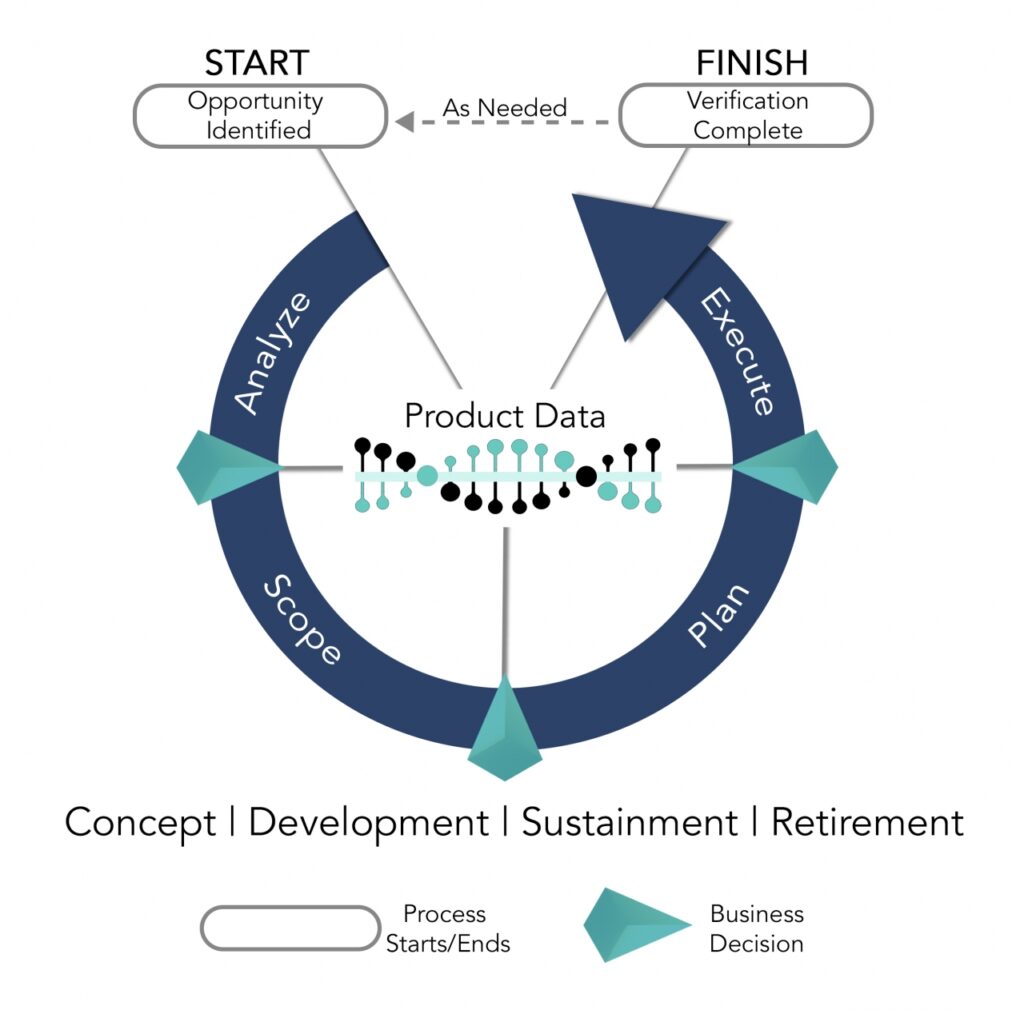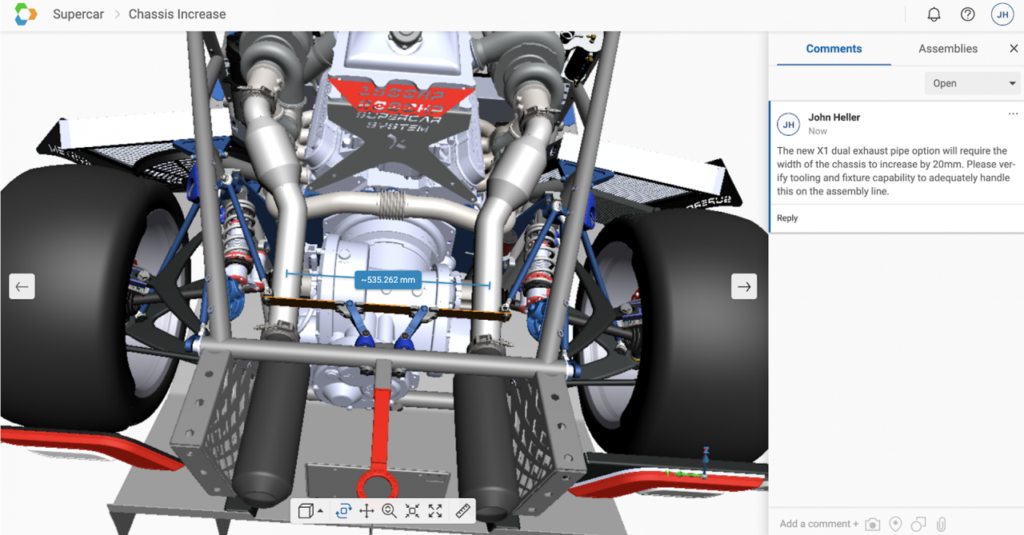Connect Your Enterprise: How To Overcome Challenges in Change Management & 3D Visualization
Maxime Gravel, IpX Director, Model Based Enterprise, and John Heller, Vertex Product Marketing Manager
Everyone has heard the expression “a picture is worth a thousand words.” Nowadays, with remote working on the rise, the need to effectively communicate visual product information is more crucial than ever. Increases in data, product complexity, and company globalization contribute to this challenge. But of course, visually communicating product information has never been easy and has only gotten more complicated.
In my experience developing and integrating change management processes and tools within the aerospace industry, I could tell countless stories of miscommunication with my colleagues. And I am sure that most of you have been involved in projects or workflows that ended up falling short of expectations. Why is that the case? I’ve partnered with John Heller at Vertex Software to uncover how companies can overcome these challenges and be successful in Industry 4.0 by properly defining and maintaining change processes and democratizing data throughout a connected enterprise.
Two Common Communication Challenges
First, let’s look at two categories of why collaboration projects may fall short. The first is there is simply a lack of common understanding of terminology. For example, as a French Canadian, I use the term “tuque” to refer to a hat people wear in the winter (what John as an American refers to as a “stocking cap”). It only gets more complicated in manufacturing enterprises. Just think about how unclear saying “the gusset” can be. This is why people love to use 3D models – they don’t have to figure out which terms to use or what they mean. They can just show a picture, and everyone knows what you’re talking about.
But the second category is precisely why there is a problem with 3D models. It is extremely difficult to get a single version that multiple individuals across the value chain can work on. I can remember spending two days reviewing and commenting on a superseded version of a drawing because I missed an email that went into my junk mail. It is common for engineers to work concurrently on two versions of the same thing.
As both John (at Vertex) and I (at IpX) engage with customers, we notice that manufacturers are still relying on alternate data formats (such as slide decks) with out-of-context information. They’re using emails to communicate physical product information, even after making a significant investment in tools and training to create accurate 3D models. Building these derived formats of the 3D model requires time and resources. It often becomes disconnected from the authoritative source of definition as the change evolves through the process.
If this is the current process, how do we disseminate 3D information in a seamless and streamlined way? From our experiences with customers, there are two main hindrances across the ecosystem to tackle (and they align very closely to IpX and Vertex’s missions): processes around configuration management and disseminating 3D data.
The Source of Truth in Change Management
The first is configuration management and a lack of process to properly define, maintain, and control the product configurations as it evolves. Many refer to this as an authoritative source of truth. The change process is an excellent example of a process that requires input from all stakeholders (engineering, manufacturing, supply chain, quality, customer, partner, vendor, and more) to ensure everyone makes proper business decisions.
To be fast and efficient, all functions must have real-time access to the right information at all times. IpX encourages a clear change process to help track input. Our CM2 closed loop change process starts at an opportunity identification and ends when the change is implemented and verified on the product. The process includes four phases (analyze, scope, plan, execute) with a set of activities that require input from multiple domains. Each phase ends with a go/no-go business decision to proceed. However, disseminating visual information throughout the change process is a topic that surprisingly receives little attention, which leads to our second hindrance that ties closely with John Heller’s experiences.

Disseminating 3D Data
All of Max’s points so far are fully in-line with my experiences working in the manufacturing industry in a variety of roles, including procurement, engineering, and customer-facing roles. To support change processes, it’s crucial that everyone in the connected enterprise has access to the most up-to-date product data. But it is very difficult, and companies struggle to get CAD, PLM, and other 3D visualization integrated throughout the enterprise. This is due to a wide variety of reasons, including lack of software licensing, security challenges, extensive training, and the sheer size of 3D models.
To support the change process—and really, to disseminate 3D information anywhere along the digital thread—Vertex provides an extremely cost-effective and easy way to build and deploy purpose-built visualization applications anywhere in your enterprise. We enable manufacturers to connect their enterprise by integrating high-fidelity visuals with your business systems, automating data flows, and delivering 3D visuals to downstream users. Let’s walk through an example of IpX’s CM2 Closed-Loop Change Process and see how providing a 3D visual overlay to different phases impacts and connects the extended enterprise.
1. Analyze: Engineering Design
In the analyze phase of the CM2 process, manufacturers seek to understand how to optimize a product and consider reusing certain parts in future design iterations. By visualizing data across the digital thread, companies can understand whether the systems and subsystems performed to their design specifications. Vertex serves as a visual user interface for the digital twin, providing full 3D across data sources, enabling manufacturers to build a closed-loop system to monitor performance parameters. Engineers spend less time digging for data and more time designing.

2. Scope: Connecting with Customers & Supply Chain
Once manufacturers move from the analyze phase into the scope phase, they look to get the right scope on the project. When connecting with customers and the supply chain to understand market acceptance and feasibility, organizations get stuck trying to move the 3D visuals in the context of the data to downstream users. The collaboration features within Vertex allow real-time access and communication with complex 3D data to any downstream teams. The team can capture valuable information and agreement without working outside the source of truth. This eliminates inefficient workflow methods that create disconnected data and costly errors.

3. Plan: Manufacturing Feasibility
Once the scope is approved, manufacturers move to the plan phase to identify the work to be done. However, implementing and staging the changes during MPP (manufacturing planning process) is extremely challenging. Vertex’s collaboration features allow real-time communication between any team to work through design-for-manufacturing and design-for-assembly issues. Vertex can also be integrated into factory floor applications such as electronic 3D work instructions and quality checks quickly for fast, efficient validation and implementation.


4. Execute: Understanding Field Service
The execution phase occurs when manufacturers release information and complete verification. As part of this, field service teams need to understand how to service potentially complex and varied products. Field service teams need to access training libraries and interactive 3D visual resources to become familiar with the changes. Traditionally, service teams have suffered from the lack of clarity inherent with 2D drawings. Vertex plugs into the enterprise service and PLM systems to align the 3D visuals of a component to service technician portals or other field service applications. This ensures that the correct service kits and repairs are administered, improving technician efficiency and customer satisfaction.

Connecting The Enterprise
At a time when digital transformation is critical to manufacturers, connecting the enterprise will ensure manufacturers stay successful. We want to know—how would connecting your enterprise with 3D visuals supercharge your digital transformation?
About IpX – the Institute for Process Excellence
IpX’s education sector is the premier worldwide industrial resource for configuration management, systems engineering, operational excellence, digital transformation and high-performance culture training with courses offered in seven languages. Today, IpX is the global industry standard for the model-based enterprise. IpX’s RISE is an evolutionary DEI platform.
IpX’s global services sector ensures their clients achieve enterprise excellence through the revolutionary True North Enterprise Calibration™ model and services. Our business engagement experts provide needed enthusiasm for change by infusing the mission throughout the enterprise and connecting leadership with its staff. IpX is the leader in organizational strategies that effectively integrate the people, processes, systems, and data of the organization. Visit us at www.ipxhq.com and follow IpX on LinkedIn and Twitter.
About Vertex Software
Vertex supercharges your digital transformation and digital twin journey. For the first time, you can provide purpose-built, 3D digital twin applications with extremely low total cost of ownership to any user downstream of engineering. Build and deploy real-time, highly performant, scalable 3D digital twin apps in under 30 days using our APIs and SDKs. Stream 3D images to any laptop, tablet, or phone. Our platform automatically flexes to handle model scale and number of users. Provide interactive 3D visuals from any new or existing application to anyone in your enterprise. Visit us at www.vertexvis.com and find us on LinkedIn and Twitter.

 Title
Title Title
Title Title
Title Title
Title Title
Title Title
Title Title
Title


 Title
Title Title
Title Title
Title